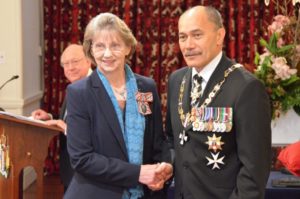 It was incredibly exciting this morning to wake to the news that Margaret had been awarded the QSM (Queen’s Service Medal) for services to hand knitted lace design in the New Year Honours list.
It was incredibly exciting this morning to wake to the news that Margaret had been awarded the QSM (Queen’s Service Medal) for services to hand knitted lace design in the New Year Honours list.
For those of us who know her well, there are many, many reasons why this is a deserved recognition and in this post I’d like to add a bit of context to what makes her work and contribution to craft as art in New Zealand so special.
Services to hand knitted lace design
In the knitting renaissance of the last five to ten years many skilled knitters have turned their hand to creating and publishing their own designs. There are two aspects of Margaret’s designs that set her apart.
- Margaret regularly designs the actual lace motif itself within her knitting. Starting with sketches she will experiment with stitch combinations until the motif represents her initial concept. In contrast the vast majority of lace knitting patterns available today are based on combinations of pre-existing designs (including the analysis and re-charting of heritage garments.)
- The inspiration for traditional knitted lace patterns that have been passed down through the generations in Europe was the local environment whether it be shells, flowers, or the flowing of the tides. In utilising her design skills to expand that foundation to include lace patterns unique to New Zealand she has contributed to our craft maturity as a country, integrating our heritage with who we are as a Pacific people.
Both these skills are evident in the Bush Bouquet and Filmy Fern shawl designs which have been used for royal baby gifts, and are also found in the examples of her work found in Te Papa Tongarewa. They set Margaret’s work apart from the skilled hobby knitter and make it impossible for her designs to be created by machine.
The bigger story
In keeping with many QSM recipients, Margaret’s contribution to the New Zealand and international knitting community goes well beyond the stated field of service.
Margaret could as easily received an award for the contribution she has made to the Merino wool industry in New Zealand. She was actively involved in the campaigns in the 80′s and 90′s to promote New Zealand merino, particularly when she was teaching and demonstrating fine merino spinning or lace knitting overseas. Whenever a knitter asks me “Is it merino?” as a measure of yarn quality I think of all the countless hours Margaret spent describing the qualities that make New Zealand merino so special.
Over the years she has developed an incredible level of expertise in the history of hand knitted lace textiles in New Zealand and internationally. A number of her articles have focused on re-creating or restoring heritage patterns. She also has a well-deserved reputation as a patient and generous teacher in sharing her skills.
Last but not least, and perhaps not such a popular topic, for going on fifty years Margaret has advocated for the right of craft artists to be paid fairly. The craft that is shared within families and friends is a labour of love – but it is still skilled labour and commercially a labourer is worthy of their hire. The spinning, design and knitting of a lace wedding ring shawl by a master knitter takes somewhere up to 400 hours – now multiply that by the hourly rate you might pay a builder, a mechanic, an architect, an interior designer. An heirloom knitted shawl can last for generations if cared for properly and is a work of art. Her insisting on the importance of pieceworkers being paid at least a minimum hourly rate and focusing on markets that can afford a premium product to sustain that, are as much a part of who she is as a craft artist as her design and teaching skills.
